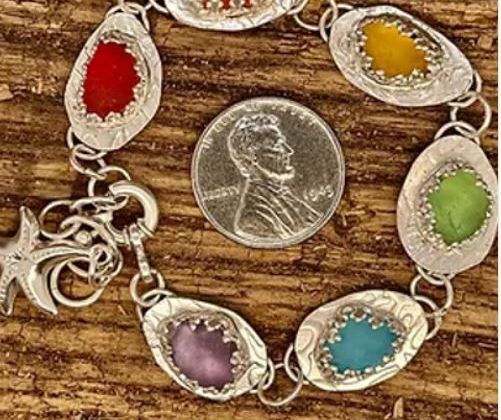Sea glass, often referred to as "mermaid's tears," is a treasure that captivates the hearts of beachcombers, jewelers, and collectors alike. Its allure lies not only in its aesthetic beauty but also in the intriguing journey it undertakes from discarded glass to a smooth, frosted gem. The story of genuine sea glass is one of transformation, patience, and the relentless power of nature.
The Formation of Genuine Sea Glass
Genuine glass begins its life as ordinary glass products—bottles, jars, windows—discarded into the ocean. Over time, these fragments are broken down by the constant motion of waves, sand, and rocks. This natural tumbling process can take decades, sometimes even centuries, to transform sharp-edged shards into the smooth, frosted pieces we recognize as sea glass. The result is a piece of glass that has been polished by nature to a silky matte finish, with rounded edges that are safe to touch.
What distinguishes genuine sea glass from artificially produced counterparts is this lengthy and intricate natural process. The texture, color, and even the level of frosting are tell-tale signs of genuine sea glass. Artificial or "tumbled" glass, while often sold as sea glass, lacks the unique characteristics imparted by years of natural wear and weathering.
The Colors of the Sea
One of the most fascinating aspects of sea glass is the wide spectrum of colors it comes in. The most common colors include shades of white, green, and brown, which originate from clear glass bottles, green beer bottles, and brown beverage containers, respectively. However, it's the rare colors that truly excite collectors. Blues, reds, purples, and pinks are highly sought after, each hinting at its own unique origin and history.
For example, cobalt blue sea glass often comes from old medicine bottles, Vicks VapoRub jars, or Noxzema containers. Red sea glass is exceedingly rare and often traces back to old nautical lanterns, signal lights, or decorative tableware. The rarity of these colors, combined with the lengthy time it takes for sea glass to form, makes them precious finds.
The Appeal of Sea Glass in Jewelry
The charm of sea glass extends far beyond its origin and appearance; it also holds significant value in the world of jewelry. Sea glass jewelry has become increasingly popular, with artisans crafting necklaces, earrings, bracelets, and rings that showcase these ocean gems. The appeal lies in the uniqueness of each piece—no two pieces of sea glass are exactly alike, each carrying its own history and journey.
Creating sea glass jewelry is an art in itself. Jewelers often design settings that complement the natural beauty of the glass, allowing its colors and shapes to take center stage. Whether set in silver, gold, or other metals, sea glass jewelry offers a connection to the ocean and a reminder of nature's ability to transform and beautify.
Environmental and Cultural Significance
Genuine Sea glass is not only a beautiful byproduct of oceanic forces but also a reminder of human impact on the environment. Each piece of genuine sea glass started as litter, illustrating the long-term effects of human waste on our oceans. The presence of sea glass serves as a subtle call to action for greater environmental responsibility and conservation efforts.
Moreover, sea glass holds cultural significance in many coastal communities. For centuries, beachcombers have searched for these treasures, incorporating them into folklore and local traditions. In some cultures, sea glass is believed to bring good luck or to have healing properties. The act of searching for sea glass itself can be meditative and grounding, providing a direct connection to nature and the rhythms of the ocean.
Identifying Genuine Sea Glass
For those new to the world of sea glass, distinguishing genuine pieces from man-made imitations can be challenging. Genuine sea glass has a distinct frosted appearance, with a smooth, velvety texture. The edges are naturally rounded, and the surface may show signs of pitting, which occurs as the glass is tumbled and eroded by the elements.
In contrast, artificial sea glass, often created by tumbling glass in machines, tends to have a less uniform frosting and may lack the natural imperfections that characterize genuine sea glass. Authenticity can often be confirmed by experienced collectors and jewelers who are familiar with the tell-tale signs of natural sea glass formation.
Conclusion
The allure of genuine sea glass lies in its unique blend of beauty, history, and environmental significance. Each piece is a testament to the transformative power of nature, turning human waste into oceanic treasure over the course of decades. Whether appreciated for its aesthetic appeal, its use in stunning jewelry, or its environmental message, genuine sea glass remains a fascinating and cherished part of our coastal heritage.
As we continue to explore and enjoy these natural gems, let us also remember the importance of preserving our oceans and reducing our environmental footprint, ensuring that future generations can share in the magic of genuine sea glass.




Top comments (0)